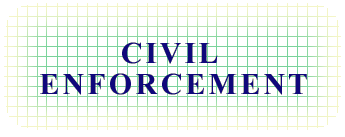
A Unique Source of
Authoritative Information about
the Federal Government's Enforcement Activities

Under American law, federal agencies have three basic enforcement tools -- criminal, civil, and administrative. This layer focuses upon civil enforcement -- when a federal agency or official sues or gets sued in a civil court action. Common causes of action include civil rights, employment, freedom of information and privacy, antitrust, consumer protection, frauds, torts, forfeitures, taxes, and prisoner suits. The federal government also frequently intervenes in private suits when the government's interest is impacted. This often occurs in bankruptcy and other kinds of commercial litigation.No single existing database covers the diversity of cases encompassed under federal civil enforcement. Unlike federal criminal enforcement, the Justice Department does not have exclusive jurisdiction to bring cases. Some agencies, such as the Securities and Exchange Commission, can file suit directly without going through Justice. Further, while criminal enforcement takes place in federal district court, with civil litigation additional court systems play a role. The volume of proceedings in state and bankruptcy courts which involve the federal government as a plaintiff, defendant, or third-party intervenor in derivative issues arising out of enforcing federal laws is surprisingly large. Illustrative of this point is the very sizable volume of civil litigation involving the assessment and collection of federal taxes.
The initial offering on this layer allows examination of the civil workload of U.S. Attorneys offices. Matters directly brought by other Department of Justice divisions or by other federal agencies without involving a local U.S. Attorney office are not included. TRAC will be adding additional databases to this layer to round out its civil coverage as our continuing FOIA efforts result in the release of additional data.
TRAC's federal prosecutors database covers referrals received by United States Attorneys and follows these referrals through to final disposition. (See Data under Help.) Cases processed in the federal district courts, as well as state and bankruptcy courts, are covered. Menus on this layer allow the user to easily restrict the analysis to a particular court system or examine litigation across these combined systems. Similarly, menu choices allow users to examine civil matters where the government is the plaintiff, defendant, or has a third-party role, and permit you to focus your analysis on particular causes of action.
Information on this layer is restricted to civil matters. Information on referrals to U.S. Attorneys for criminal prosecutions are found on the criminal enforcement layer. The most recent data can be found using the Analyzer tool. Now updated through the first 3 months of FY 2004 (December 2003).
Special caution should be used in interpreting results from this layer. Because in this initial offering information available is limited to matters which are part of the workload of U.S. Attorneys offices, conclusions can only be drawn about this component of the federal government's civil enforcement role. While U.S. Attorneys do handle the majority of cases in the U.S. district court, substantial gaps in coverage exist and users should be aware that these may have changed over time, complicating year-to-year comparisons.
Copyright 2004, TRAC Reports, Inc.